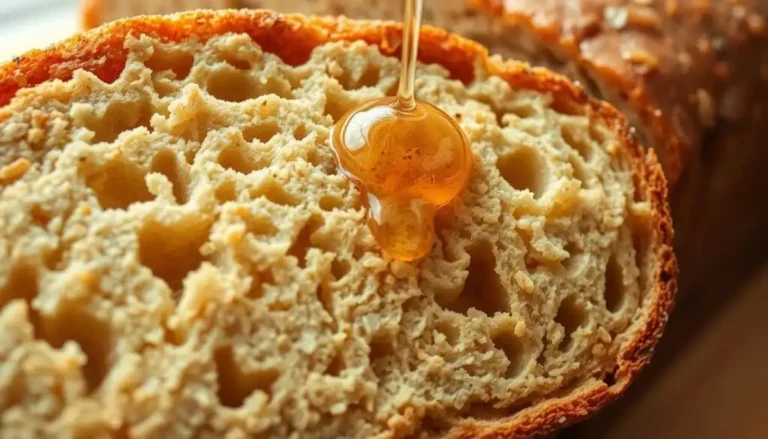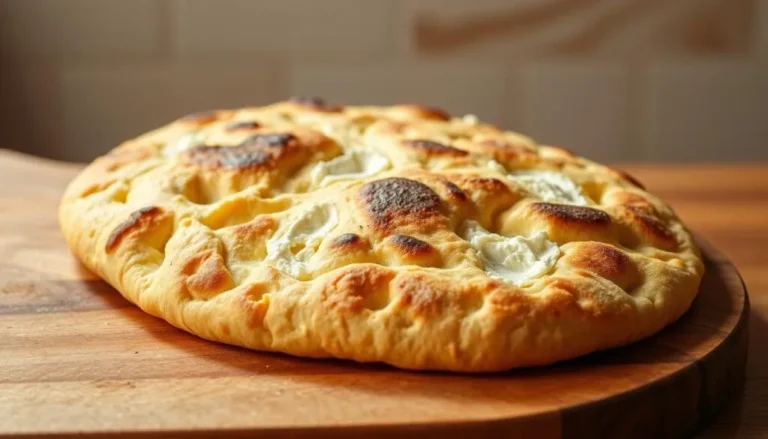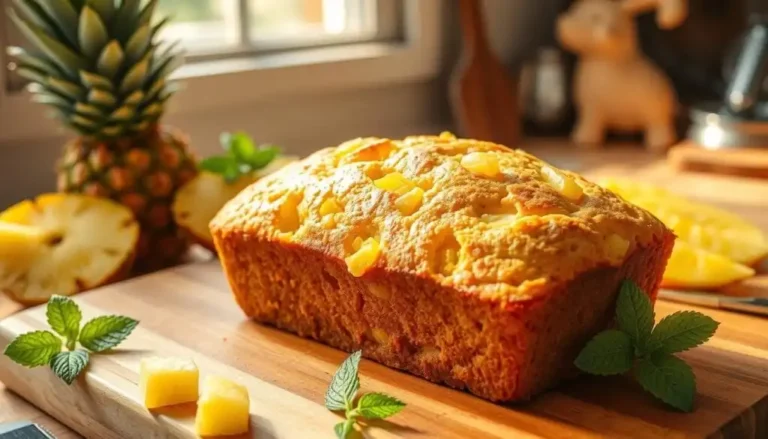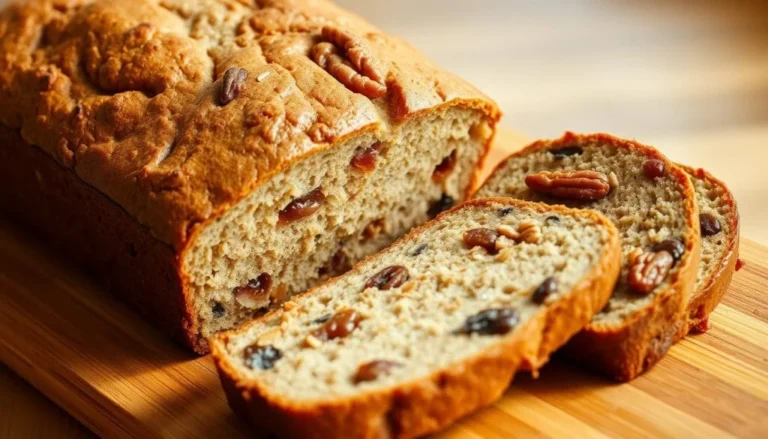How to Make Einkorn Bread: A Beginner’s Guide with Einkorn Bread Recipes
The first time I baked einkorn bread, something magical happened. The aroma filled my kitchen, reminding me of generations of bakers. Einkorn bread recipes are more than ingredients; they’re about connecting with an ancient tradition.
Baking with einkorn flour is a journey into heritage wheat’s world. This grain has survived for thousands of years. It lets home bakers make bread that’s delicious, nutritious, and full of history.
If you’re new to baking or love traditional cooking, this guide is for you. We’ll cover everything you need to know about making perfect einkorn bread. You’ll learn about techniques, ingredients, and the magic of this ancient grain.
Table of Contents
Understanding Einkorn Flour and Its Ancient Origins
Einkorn wheat is a grain with a long history, dating back thousands of years. It connects us to our past and offers great nutrition for today’s recipes.
It started in the Fertile Crescent about 10,000 years ago. This ancient wheat is now being rediscovered for its unique traits and health benefits.
The Nutritional Benefits of Ancient Wheat
Einkorn wheat is a nutritional powerhouse. It has:
- Higher protein content
- More minerals and antioxidants
- Lower gluten levels
- Enhanced nutrient absorption
How Einkorn Differs from Modern Wheat
| Characteristic | Einkorn Wheat | Modern Wheat |
|---|---|---|
| Chromosomes | 14 chromosomes | 42 chromosomes |
| Gluten Structure | Simpler protein formation | Complex protein structure |
| Digestibility | More easily digested | Potentially harder to digest |
Why Choose Einkorn for Baking
Choosing einkorn for baking has many benefits. It adds depth to recipes and is a healthier choice than regular wheat flour.
“Einkorn is not just a grain, it’s a culinary time machine connecting us to our ancestral food traditions.” – Agricultural Historian
Bakers love einkorn for its light texture and rich taste. It’s also great for those who want easier-to-digest bread without losing flavor or nutrition.
Essential Tools and Equipment for Baking Einkorn Bread
Starting your einkorn flour baking journey needs the right tools for success. Both professional bakers and home cooks know that good equipment makes a big difference. It turns your bread-making into a special experience.
To bake delicious einkorn bread, you’ll need some key tools. The right gear helps work with einkorn’s unique traits. It also supports the bread’s best development.
- Large mixing bowl with ample space for kneading
- Digital kitchen scale for precise ingredient measurements
- Sturdy wooden spoon or Danish dough whisk
- Proofing basket (banneton) for shaping
- Baking stone or Dutch oven
“The right tools can elevate your einkorn bread from good to absolutely magnificent.” – Artisan Baker
Baking with einkorn flour needs special tools, unlike wheat bread. A kitchen thermometer is key for dough temperature. A bench scraper helps with einkorn’s special dough texture.
| Tool | Purpose | Recommended Type |
|---|---|---|
| Kitchen Scale | Precise Ingredient Measurement | Digital, Accurate to 1g |
| Proofing Basket | Dough Shaping | Rattan Banneton |
| Baking Stone | Even Heat Distribution | Cordierite Ceramic |
Quality tools will greatly improve your einkorn bread baking. Start with these basics and add more as you get better at making bread.
Ingredients Guide for Perfect Einkorn Bread
Making great einkorn flour bread starts with the right ingredients. These ingredients turn simple parts into a tasty loaf. Your bread’s quality depends on choosing the best ingredients and knowing how they work together.
Selecting Quality Einkorn Flour
Choosing the right einkorn flour is key to your bread’s success. Unlike modern wheat, einkorn flour has two main types:
- Whole grain einkorn flour (more nutritious)
- All-purpose einkorn flour (lighter texture)
Understanding Hydration Levels
Einkorn flour soaks up water differently than regular wheat flour. Your einkorn flour bread recipe needs careful water attention. Einkorn usually needs a bit more water because of its special protein structure.
“The secret to perfect einkorn bread lies in mastering hydration” – Artisan Baker
Salt, Yeast, and Additional Ingredients
Your einkorn flour bread recipe’s taste and rise depend on top-notch ingredients:
| Ingredient | Recommended Type | Purpose |
|---|---|---|
| Salt | Sea salt or kosher salt | Enhances flavor, controls yeast growth |
| Yeast | Active dry or instant yeast | Provides rise and texture |
| Optional Add-ins | Seeds, herbs, honey | Adds complexity and nutrition |
Pro tip: Always use fresh ingredients for the best einkorn flour bread recipe results.
Best Einkorn Bread Recipes for Beginners
Exploring einkorn bread recipes can change your baking world. This ancient grain brings unique tastes and health benefits. It makes baking at home fun and rewarding, whether you’re new to baking or want to try traditional wheat.
Begin with these easy einkorn bread recipes to build your kitchen confidence:
- Classic Einkorn Sandwich Loaf
- Perfect for first-time bakers
- Soft texture with rich, nutty flavor
- Simple ingredients and straightforward method
- Rustic Einkorn Boule
- Crispy crust with tender interior
- Great for weekend baking projects
- Minimal kneading required
- Easy Einkorn Dinner Rolls
- Quick to prepare
- Ideal for family meals
- Versatile recipe for beginners
“Baking with einkorn is like connecting with thousands of years of culinary tradition.” – Ancient Grain Baker
These einkorn bread recipes teach you new techniques but keep it simple. The key is to enjoy the unique qualities of einkorn flour and the learning journey.
Einkorn flour is different from modern wheat. It needs less kneading and has less gluten. This means your bread-making approach will be unique. Don’t worry if your first loaf isn’t perfect – with practice, you’ll get better!
Mastering the Einkorn Bread Kneading Technique
Baking with einkorn flour needs a special kneading method. It’s different from kneading wheat dough. Learning the right techniques can make your bread-making better and healthier.
Hand Kneading vs. Machine Mixing
There are two main ways to knead einkorn flour:
- Hand Kneading: Gives you more control and a closer feel to the dough
- Machine Mixing: Makes the process consistent and easier on your hands
“The key to perfect einkorn bread lies in understanding its unique texture and handling requirements.” – Artisan Baker
Signs of Proper Dough Development
Knowing when your einkorn dough is ready involves looking for certain signs:
- It should feel smooth and elastic
- It should slightly resist when you stretch it
- It should keep its shape without tearing easily
Troubleshooting Common Kneading Issues
Einkorn flour is more delicate than modern wheat. Here are some common challenges you may encounter:
- Don’t over-knead, as it can make the dough tough
- Make sure it’s well-hydrated
- Use gentle, folding motions
Being patient and practicing will help you get the hang of kneading einkorn flour.
Proofing and Fermentation Tips for Einkorn Dough
Mastering the proofing process is key when working with einkorn wheat recipes. This ancient grain needs special care during fermentation. It helps develop rich flavors and the perfect bread texture.
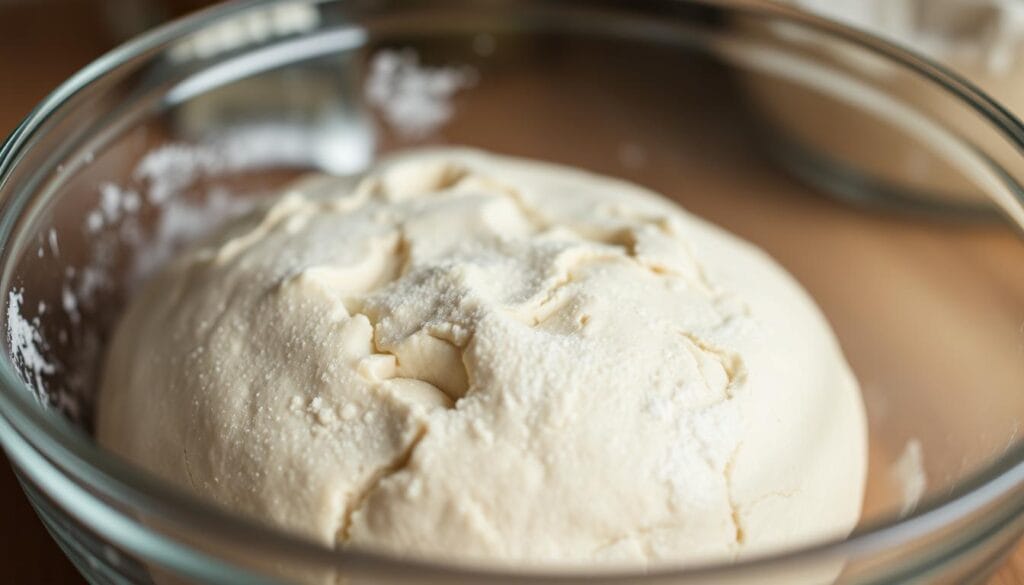
Einkorn dough is different from modern wheat. Its unique protein structure means you’ll need to adjust your bread-making techniques. Fermenting einkorn wheat recipes requires patience and careful observation.
“Slow fermentation is the secret to unlocking the full potential of einkorn flour.” – Artisan Baker
Key Proofing Considerations
- Monitor temperature carefully (ideally between 70-75°F)
- Watch for subtle signs of dough development
- Allow longer fermentation times compared to modern wheat
- Use gentle handling to preserve dough structure
Fermentation Time Guide
| Fermentation Stage | Typical Duration | Key Characteristics |
|---|---|---|
| Bulk Fermentation | 2-4 hours | Dough becomes puffy, increases in volume |
| Final Proof | 1-2 hours | Develops complex flavors, increases bread volume |
Professional bakers suggest using a room temperature environment for optimal einkorn wheat recipes fermentation. Your dough is ready when it shows gentle bubbling and has increased about 50% in volume.
Pro tip: Use a clear container to track your dough’s rise and prevent over-proofing. Gentle finger pokes can help you determine the perfect proofing point for your einkorn bread.
Shaping Your Einkorn Bread Loaf
Learning to shape your einkorn flour bread recipe turns simple dough into a beautiful loaf. The right way to shape it can make a big difference. It affects the bread’s texture, rise, and look.
Basic Shaping Techniques
When working with einkorn flour, knowing basic shaping methods is key. You need to create surface tension. This helps the bread keep its shape while it bakes.
- Fold the dough gently to create a smooth surface
- Use light touches to prevent deflating the dough
- Rotate the dough while shaping to ensure even development
Creating Different Bread Styles
With your einkorn flour bread recipe, you can make many different bread styles. Just change your shaping technique a bit.
| Bread Style | Shaping Technique | Difficulty Level |
|---|---|---|
| Boule | Round, circular motion | Beginner |
| Batard | Oval, gentle rolling | Intermediate |
| Baguette | Elongated rolling | Advanced |
“Bread shaping is an art that transforms simple ingredients into culinary masterpieces.” – Artisan Baker
Getting better at shaping einkorn flour bread takes practice. Start with the basics and then try more complex styles.
Baking Temperature and Time Guidelines
Getting your einkorn bread just right needs careful temperature and timing. Knowing the baking process well helps you make loaves with a crispy outside and soft inside.
It’s key to preheat your oven well for einkorn bread. Experts say to set it between 425°F and 450°F for the best results. This temperature helps the crust cook right and the inside get done.
“The secret to great einkorn bread is mastering your oven’s heat.” – Artisan Baker
Baking Time Guidelines
- Small loaves (1 lb): 30-35 minutes
- Medium loaves (1.5 lbs): 35-40 minutes
- Large loaves (2 lbs): 40-45 minutes
Checking Bread Doneness
To see if your einkorn bread is done, try these ways:
- Check the internal temperature, aiming for 190-210°F
- Tap the loaf’s bottom; it should sound hollow
- Look for a golden-brown crust
| Baking Method | Temperature | Recommended Time |
|---|---|---|
| Dutch Oven | 435°F | 35-40 minutes |
| Baking Stone | 450°F | 30-35 minutes |
| Standard Oven Tray | 425°F | 40-45 minutes |
Pro tip: To get a crisp crust, put a shallow pan of water on the bottom rack while baking. This method works wonders for your einkorn bread.
Storage and Preservation Methods
Keeping your homemade einkorn sourdough sandwich bread fresh is key. After baking, you’ll want it to stay delicious for a long time.
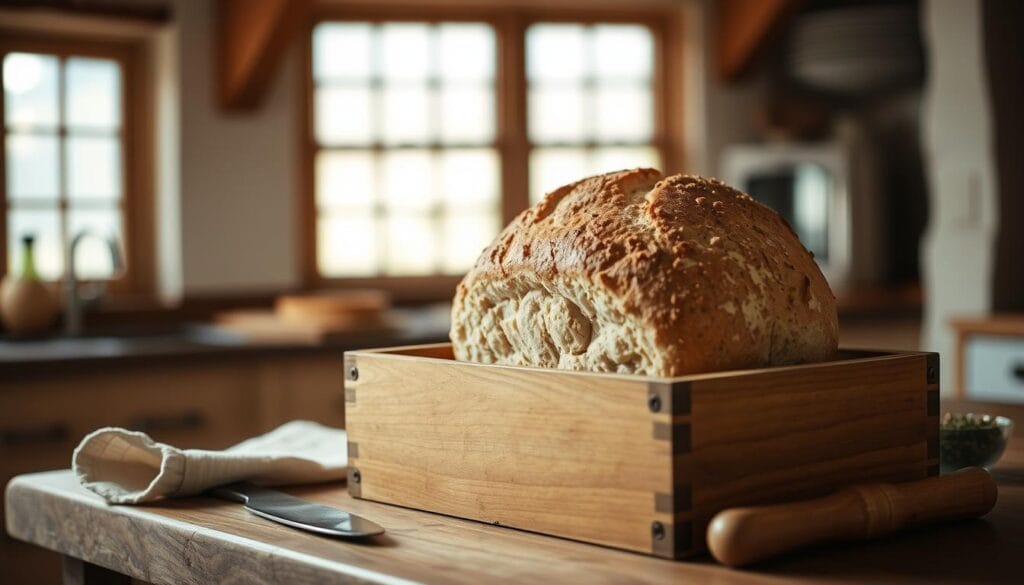
Keeping Your Bread Fresh
Einkorn bread doesn’t last as long as store-bought bread because of its natural ingredients. Here are some tips to maintain its freshness:
- Cool your einkorn bread completely before storing
- Use breathable bread bags or paper wrapping
- Store at room temperature for a maximum of three days.
- Avoid plastic bags, which can trap moisture
Freezing and Thawing Tips
Freezing is a great way to keep your einkorn sourdough sandwich bread fresh longer. The right freezing methods can preserve its quality and taste.
- Slice the bread before freezing to simplify portioning.
- Wrap securely in plastic wrap, then cover with aluminum foil.
- Place in a freezer-safe container or bag
- Freeze for up to 3 months
“The key to preserving einkorn bread is protecting it from moisture and air” – Artisan Bread Experts
When thawing, let the bread sit at room temperature for about an hour. Avoid microwaving to prevent it from becoming tough and chewy.
Pro tip: Turn day-old einkorn bread into delicious croutons, breadcrumbs, or French toast. This way, you can enjoy its unique flavor without wasting it.
Troubleshooting Common Einkorn Baking Challenges
Baking with einkorn flour can be tricky, even for experts. Knowing the common issues helps you make perfect bread every time.
When using einkorn flour, you might face several common problems. These issues come from einkorn’s special protein structure and less gluten than modern wheat.
- Dense or Gummy Bread: Caused by over-mixing or incorrect hydration
- Lack of Rise: Result of insufficient kneading or weak yeast
- Crumbly Texture: Often due to incorrect moisture balance
“Patience and practice are key when mastering baking with einkorn flour.” – Artisan Baker’s Wisdom
To solve these problems, try these tips:
| Problem | Solution |
|---|---|
| Dense Bread | Reduce kneading time, increase hydration by 10-15% |
| Poor Rise | Use fresh yeast, allow longer proofing time |
| Crumbly Texture | Add extra liquid, use room temperature ingredients |
Experts suggest starting small and playing with liquid levels. Einkorn soaks up liquid differently than modern wheat, so tweak your recipes.
Baking with einkorn flour needs a gentle approach and careful watching. Each loaf is a chance to learn and get better at working with this ancient grain.
Creating Variations with Your Basic Einkorn Recipe
Mastering the basic einkorn wheat recipe is just the start. It opens the door to endless culinary adventures. With einkorn, you can explore new flavors and textures in your bread.
- Add crunchy seeds like sunflower, pumpkin, or sesame
- Add dried fruits like cranberries or raisins.
- Experiment with herbs like rosemary or thyme
- Blend in nuts for extra nutritional value
Einkorn’s magic is in its flexibility. You can turn your basic bread into many styles:
| Bread Style | Key Ingredients | Flavor Profile |
|---|---|---|
| Herb Bread | Fresh herbs, garlic | Savory, aromatic |
| Sweet Bread | Honey, cinnamon | Warm, comforting |
| Seed Bread | Mixed seeds | Crunchy, nutritious |
Pro tip: Start with small modifications to understand how each ingredient impacts your einkorn bread’s texture and taste.
“Baking is an art, and einkorn wheat is your canvas!” – Artisan Baker
Remember, einkorn recipes are forgiving and encourage experimentation. Don’t be afraid to mix, match, and create your signature bread!
Conclusion
Baking with einkorn flour opens a world of culinary exploration. You’ve moved from a beginner to a confident home baker. This journey not only gives you delicious bread but also a deeper appreciation for traditional baking.
Every loaf you make is more than a simple recipe. It shows your growing skill in using this nutritious grain. You’ve learned important techniques like kneading and understanding hydration levels. These skills will help you make many different einkorn breads.
As you keep baking einkorn bread, remember that practice makes perfect. This ancient grain connects you to generations of bakers. Your kitchen becomes a place of discovery, where old techniques meet new enthusiasm.
The world of einkorn baking is exciting and vast. You have the skills to make nutritious, flavorful bread that’s different from standard wheat recipes. Keep exploring, baking, and enjoying the delicious journey of making einkorn bread.
FAQ
What is einkorn flour, and how is it different from regular wheat flour?
Is einkorn bread a good option for those with gluten sensitivities?
How does baking with einkorn flour differ from baking with regular flour?
Can I substitute einkorn flour directly in my existing bread recipes?
Where can I purchase high-quality einkorn flour?
How should I store einkorn flour to maintain its quality?
Is einkorn bread more nutritious than bread made with modern wheat?
Can I make sourdough bread with einkorn flour?
Are there any special equipment requirements for baking with einkorn flour?
How does the taste of einkorn bread compare to regular bread?
Tried Our Recipe? Let Us Know What You Think!
There are no reviews yet. Be the first one to write one.


